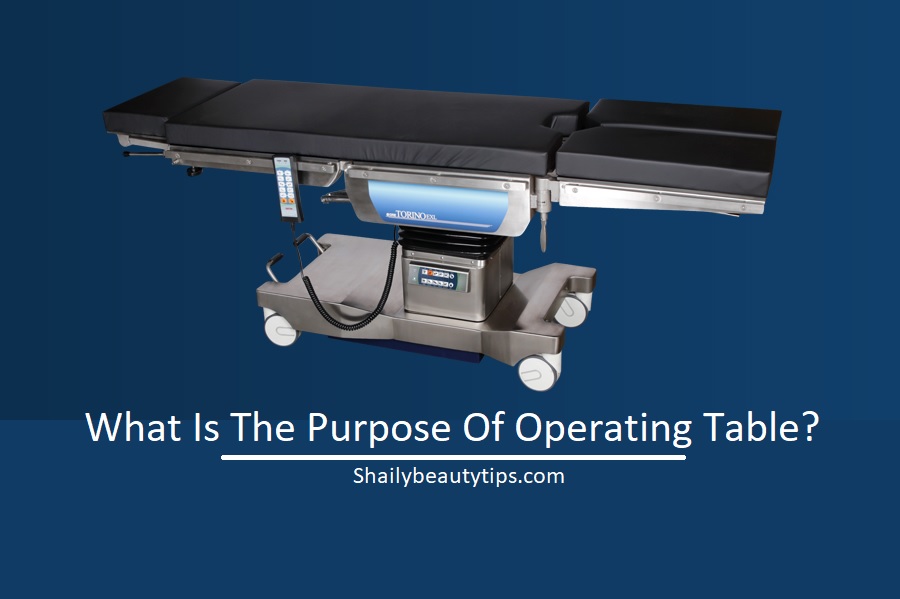Operating tables are medical equipment used for surgery. The primary purpose of an operating table is to immobilize the patient, keeping him/her in place, while surgeons or procedure doctors operate or perform surgical procedures. Operating tables have a variety of accessories that may aid in the procedure such as moving arms, legs, or body position, as well as straps and a system to keep patients still during the procedure.
Purpose Of Operating Table
One purpose of the operating table is to hold the patient still so that the doctors and nurses involved with the surgery do not need to concentrate on holding a patient as they work. This helps them perform their duties freer, which may potentially lead to a more successful operation. It may consist of a metal frame with adjustable legs and an adjustable back that supports the patient when they are lying on their back.
Surgeons perform a variety of surgeries on the chest and abdomen, both open and laparoscopic. During any of these procedures, the patient’s body stays safe on a surgical table. Using accessories like leg holders can help the surgeon have easy access to the patient’s legs and stay out of the field of vision.
An operating table is a table upon which the patient receives medical care. In a hospital or other medical facility, the table is located in an operating room. Operating tables are used in areas of medicine where the patient’s body is exposed for surgery or examination by medical practitioners.
A high level of requirements is placed on operating tables, as they are exposed to a wide variety of equipment and environments. Operating tables used in complex surgical operations should include essential functions. Such as breathable fabric mattresses or absorbent pads inside the operating table cover, non-toxic and virtually dust-free materials for covering surfaces. Adjustable pressure points without projections can harm the surgeon or patient.
Luminous safety bands for easy orientation when moving in the dark theatre environment and hard-wearing operating table covers manufactured from fire-retardant materials. Operating light source adjustment is also very important, especially if the surgeon is to be positioned above the patient’s head to allow maximum visibility during the operation phase.
Use Of The Operating Table
Surgeons and other medical staff who perform surgical procedures need an operating table that meets their needs. The operating room is a sterile area, meaning all equipment must be clean and free of germs. An operating table is one of the main items in the operating room and contributes to its sterility. The design of an operating table should allow the patient to be positioned securely while allowing the surgical team freedom of movement around the patient.
Weight and height restrictions are common features of surgical tables. This is because many procedures like orthopaedic, gynaecology and pediatric surgeries require specialized equipment and the use of proper positioning. Tables must be able to accommodate the weight of a patient along with safety systems that prevent patient injury. Surgical tables come in a variety of shapes, sizes, and styles for different types of procedures.
Types
A surgical team generally chooses a table that is suited to the type of surgery to be performed. There are several types of tables on which surgeons can perform surgery.
For Brain Surgery
A specific kind of operating table is required for brain surgery. The elements that make a regular operating table capable of dealing with the harsh conditions of surgery are not useful in brain surgery. Different kinds of tables are used because they provide a much more secure patient interface than those used in other types of surgeries.
Brain surgery is a highly invasive, risky procedure that requires the patient to remain absolutely still. Operating room tables are built to keep the patient’s head and upper back in place while surgeons operate through an opening in their skull.
For Orthopedic Surgery
Fracture tables are used in orthopedic surgeries, such as setting broken bones. Pediatric fracture tables are for smaller patients, and bariatric surgery tables are for larger patients. Surgical tables have become increasingly specialized as modern surgery has advanced. Although many surgeons still use the standard operating table that has been in use since the early 20th century, various types of speciality surgical tables are gaining popularity.
Many operating tables can accommodate a C-arm imager, which allows surgeons to see X-rays and other imagery on the table’s translucent surface during certain operations. Modern surgical equipment often contains interchangeable head and foot sections and sliding tabletops, enabling ease of movement during surgery.
For Robotic Surgery
Tables containing hydraulic mechanisms allow them to elevate to accommodate robotic equipment. These are useful in robotic surgery. A low operating table lets staff working behind the surgeon sit comfortably and still see the operation. Surgeries that take several hours to complete can be tedious for those witnessing them, so a comfortable environment that allows staff to sit during long surgeries is beneficial.
For Cardiac Surgery
A cardiac operating table is a hybrid, combining two types of tables into one. The table has a special area where a catheter can be inserted so that cardiologists can perform diagnostic tests before surgery. This can reduce stress on patients and staff by eliminating the need to move the patient to another piece of equipment.
Conclusion
An operating table is a must-have piece of equipment that every hospital or healthcare facility. From its ability to adjust to the many materials that are used, to the variety of styles you can choose from, an operating table can be a crucial piece of equipment for performing surgeries.
Operating tables are important because they put patients in the right position for surgery to be able to take place. The table is designed to make a patient feel comfortable, which generally has a positive effect on the health of the patient. Without an operating table, it would be much harder for surgeons to perform operations which makes them an integral part of the medical field.


